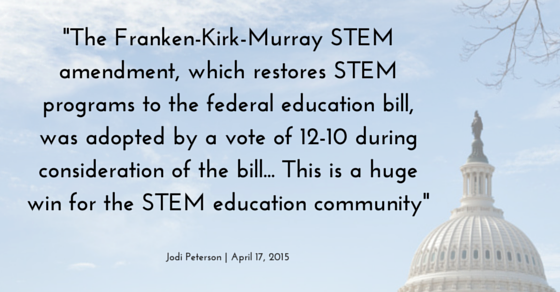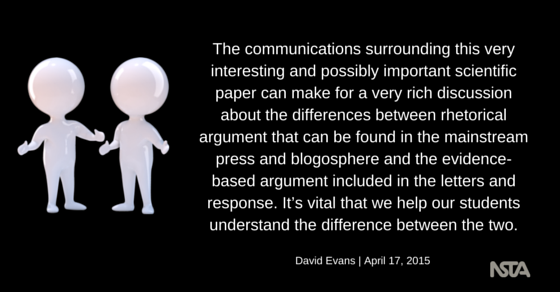Senate Education Committee Passes ESEA Reauthorization Bill
By Jodi Peterson
Posted on 2015-04-17
 On Thursday April 16, 2015, on a unanimous vote of 22-0, the Senate HELP Committee approved a bipartisan bill that rewrites the Elementary and Secondary Education Act (No Child Left Behind). This means the bill will go to the Senate floor for final consideration, although floor time has not yet been scheduled.
On Thursday April 16, 2015, on a unanimous vote of 22-0, the Senate HELP Committee approved a bipartisan bill that rewrites the Elementary and Secondary Education Act (No Child Left Behind). This means the bill will go to the Senate floor for final consideration, although floor time has not yet been scheduled.
During Senate markup of the bill, known as the Every Child Achieves Act, 60 amendments were debated, 21 amendments offered and withdrawn, 29 amendments were passed, and 8 amendments failed. See the list of amendments here. Most of the amendments were adopted via voice vote with little controversy or withdrawn out of respect for maintaining the bipartisan nature of the legislation.
I’m pleased to note that the Franken-Kirk-Murray STEM amendment, which restores STEM programs to the federal education bill, was adopted by a vote of 12-10 during consideration of the bill. The amendment language stipulates that each state receive formula-based funding to support partnerships between local schools, businesses, universities, and non-profit organizations to improve student learning in the critical STEM subjects. Each state would choose how to spend and prioritize these funds, which can support a wide range of STEM activities from in-depth teacher training, to engineering design competitions, to improving the diversity of the STEM workforce. This is a huge win for the STEM education community. See More Details on Franken-Kirk-Murray STEM Funding Amendment.
NSTA was very active in advocating for this amendment. We also spearheaded a letter with the STEM Coalition to Senate HELP Committee leaders urging support for STEM education as an ESEA priority. The letter was signed by a diverse array of more than 90 local, state, and national organizations that includes teacher and education groups, and professional and civic societies, and major corporations. Read the letter here.
Three amendments also to note, now part of the bill: An amendment from Sen. Richard Burr, R-N.C. would alter the Title II funding formula so that it’s based 80 percent on poverty and 20 percent on population.
An amendment by Sen. Tammy Baldwin, D-Wis., would allow states to use federal funds to audit the number and quality of tests and eliminate any they deem ineffective or of low-quality. The same provision was adopted in the House ESEA bill.
There were also a number of amendments relating to Title I portability introduced then withdrawn, that would allow funding for low-income students to follow those students to the public or private school of their choice. It is expected that these amendments, and amendments to strengthen the accountability system, will be offered during floor debate in the Senate.
My April 10 blog post outlines most of what is in the Every Child Achieves Act and you can read more about the mark up in this Education Week blog. Hill staffers are now incorporating amendment language into the bill, and we will bring you the final product when it is released and news on when/if this bill will reach the Senate floor.
Stay tuned and look for upcoming issues of NSTA Express for the latest information on developments in Washington, DC.
Jodi Peterson is Assistant Executive Director of Legislative Affairs for the National Science Teachers Association (NSTA) and Chair of the STEM Education Coalition. e-mail Jodi at jpeterson@nsta.org; follow her on Twitter at @stemedadvocate.
The mission of NSTA is to promote excellence and innovation in science teaching and learning for all.
Follow NSTA
 On Thursday April 16, 2015, on a unanimous vote of 22-0, the Senate HELP Committee approved a bipartisan bill that rewrites the Elementary and Secondary Education Act (No Child Left Behind).
On Thursday April 16, 2015, on a unanimous vote of 22-0, the Senate HELP Committee approved a bipartisan bill that rewrites the Elementary and Secondary Education Act (No Child Left Behind).
Science and the Media
By David Evans, NSTA Executive Director
Posted on 2015-04-17
Scientists Christian Tomasetti and Bert Vogelstein published an article in the journal Science, “Variation in cancer risk among tissues can be explained by the number of stem cell divisions” (Science, January 2, 2015, p 78). The discussion this article engendered provides an excellent teaching tool for teachers to showcase how scientific debate takes place among members of the scientific community with the goal to elevate the quality of a body of knowledge and how it is different from the way the popular press reports on and communicates this work.
The amount and range of news coverage this research article received was remarkable. Most of the popular press, unfortunately, reported a simplified version of the story citing the statement that two-thirds of cancers are caused by chance and not by genetic or environmental factors without noting that that the authors explicitly stated that a number of the most commonly occurring cancers were not included in their study. Few of the news accounts reported that the original article addressed variation in cancer risk but not absolute cancer risk, therefore misleading readers that most cancers are due to ‘bad luck.’ The Guardian ran a story, “Bad luck, bad journalism and cancer rates,” that tried to clarify the science for the popular media and provided a simple account of the actual work while chastising colleagues in the news business.
In contrast to often poorly reasoned discussion in the popular press, members of the science community weighed in with criticism as well. Authors of six letters in the journal Science raised a number of mathematical and procedural questions about the work. Many of them were also as concerned with how people would interpret the results as they were with identifying errors. For example, the letter by Ashford, et al., begins “The report […] is dangerously misleading….” And in a subsequent blog post, one of the authors writes, “Our letter to the editor of Science not only challenges the misstatements of the reports that most cancers are due to ‘bad luck’, but points out that such misstatements dangerously undermine successful efforts to prevent cancers.”
In their response to the letters, Tomasetti and Vogelstein address each of the technical points either directly or by referring to the Supplementary Materials published online by Science. They also offer their views on the non-scientific aspects of the criticism. I encourage you to read the letters as well as the response.
The communications surrounding this very interesting and possibly important scientific paper can make for a very rich discussion about the differences between rhetorical argument that can be found in the mainstream press and blogosphere and the evidence-based argument included in the letters and response. It’s vital that we help our students understand the difference between the two.
 Dr. David L. Evans is the Executive Director of the National Science Teachers Association. Reach him at devans@nsta.org or via Twitter @devans_NSTA.
Dr. David L. Evans is the Executive Director of the National Science Teachers Association. Reach him at devans@nsta.org or via Twitter @devans_NSTA.
The mission of NSTA is to promote excellence and innovation in science teaching and learning for all.
Follow NSTA


